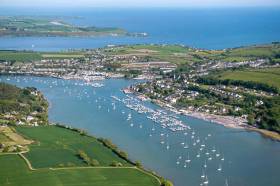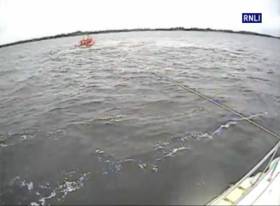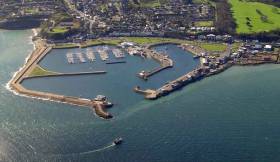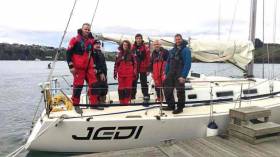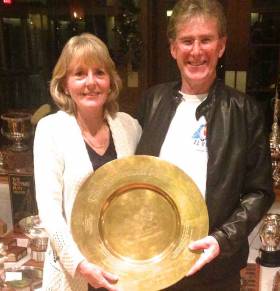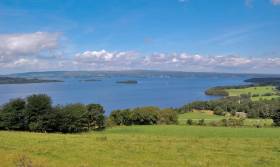Displaying items by tag: Cruising
Royal Irish Yacht Club to Provide 'Open House' for All South Seas Cruising Enthusiasts
Any cruising enthusiast or would-be cruising enthusiast who has ever dreamt of sailing away in their own boat to the balmy climate and sheltered islands of the Pacific and other warm and sunny destinations is welcome at the Royal Irish Yacht Club in Dun Laoghaire on Thursday December 7th at 7.30pm writes W M Nixon.
The Club is hosting a talk by one of the most remarkable couples in Irish sailing, Myra Reid and Paraic O’Maolriada of Kinsale. When their retirement was approaching, they had a plan. They’d buy a boat, and sail round the world. They hadn’t done much sailing, if any, before. But they felt confident that with research and good advice, they could source the right boat, and once they’d learnt the basics of sailing, their skills would improve as they sailed along.
They started extremely well by buying a 1996 Amel Super Maramu 54 ketch - the gold standard in trouble-free ocean cruisers. They called her Saol Eile, and off they went. They’d thought they’d be gone maybe two years, but it took six because they were enjoying themselves so much. And then when they slipped quietly back into Kinsale in July 2016, it was a while before the Irish sailing community fully realised the wonder of what they’d done.
But now the word is getting out that Myra and Paraic have lots to tell, and the RIYC is keen to help them share their experiences with others. So all interested cruising and sailing folk are welcome at the club on Thursday December 7th, and for €27 you can have supper afterwards, an ideal opportunity to continue to exchange ideas on fulfilling the dream
Officially, the show is titled:
AROUND THE WORLD IN 80 DAYS (+ 1,724)
“How a couple late in life with zero knowledge of sailing learnt to sail, and went on to do a circumnavigation of the globe. They experienced six years of unexpected pleasure and thrills, and made many new friends. Myra Reid and Padaric O’Maolriada with their yacht Saol Eile”
It sounds like an ideal opportunity to get a few like-minded friends together for an informative and entertaining evening, but be warned that what you hear may be life-changing……..If you want to have supper in the club afterwards, contact RIYC catering through [email protected]
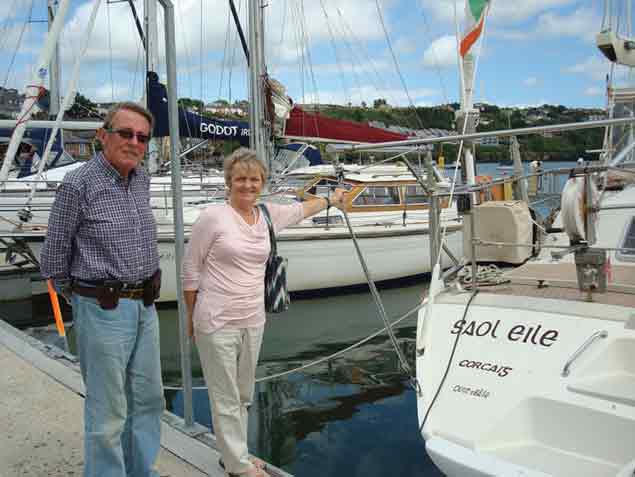 Paraic and Myra in Kinsale with their sailing home for six wonderful years
Paraic and Myra in Kinsale with their sailing home for six wonderful years
Cruising Association of Ireland Summer Cruise to Belfast Lough
The Cruising Association of Ireland held its summer cruise to Belfast Lough in early July 2017.
Fourteen boats comprising over forty sailors of varying ages gathered in Bangor Marina, County Down and were welcomed there by David Meeke and Betty Armstrong from the Royal Ulster YC, who acted as local organisers and publicists of events for the cruise. The marina manager, Kevin Baird, provided a barbecue for the participating sailors and supplied wine and beer for the evening. The following day the sailors visited the Walled Gardens in Bangor and afterwards met the Ards and North Down Mayor, Councillor Robert Adair, who welcomed us to Bangor and explained his duties as Mayor and the functioning of the town council. Afterwards we were treated to lunch and were given a guided tour of the town hall. The sailors were invited to the Royal Ulster Yacht Club for a splendid buffet that evening. The Vice Commodore Nigel Hamilton and Honorary Treasurer Phil Davis welcomed us to the magnificent clubhouse and the excellent dinner was enjoyed by all. One of our young sailors, Caoimhe McCormick, addressed the group to explain her fundraising for the Rapunzel Organisation. This group supports cancer patients with hair loss due to their treatment. Caoimhe explained that she would have her long hair cut short and that her tresses would be used to make a hair replacement wig for a victim of cancer. She raised a large sum of money in donations from our sailors.
The fleet proceeded the next morning to the Belfast Harbour Marina located in the Abercorn Basin. On the afternoon of our arrival we had a guided tour of the Belfast Harbour Commissioners Offices. The next day many sailors visited the local attractions in the Titanic quarter. HMS Caroline is the only surviving vessel from the Battle of Jutland and this new attraction is now open to the public – it is an amazing ship and well worth the effort. Titanic Belfast also proved popular and the Nomadic tender vessel has been refurbished which adds to the visitor experience. In the afternoon there was a civic reception with the Lord Mayor of Belfast, Councillor Nuala McAllister. She welcomed us to Belfast City Hall and the commodore of the CAI, Clifford Brown, presented her with a CAI burgee. In his address to the Lord Mayor he stressed the importance of maintaining open sailing waters between the North and South of Ireland so that sailors can enjoy the many amenities in Irish coastal waters. The sailors then enjoyed a guided tour of the magnificent Belfast City Hall.
After two days in Belfast, the fleet proceeded to Carrickfergus Marina. We were welcomed there by the Harbourmaster, Nigel Thompson, and the Commodore of Carrickfergus Sailing Club, Trevor McCaig, and the members of the sailing club. An evening of traditional music was enjoyed in the clubhouse and some of our sailors participated in the entertainment. The next morning was the deciding match in the Lions rugby Tour of New Zealand. A large group of sailors watched the match in Ownies Bar and enjoyed an Ulster fry for breakfast. That evening the proprietor of the bar, Jack, hosted a barbecue for the group in the beer garden. A musician was in attendance to entertain us as we ate and a sing- song developed as the evening progressed. Many talented sailors regaled the group with renditions of popular and less known songs.
The next morning the fleet of boats departed Carrickfergus with some continuing to cruise further north, some going to Scotland and the Isle of Man and some returning home. The cruise was a great success and everyone was made very welcome in the places we visited. New friendships were established and the CAI is very indebted to David and Betty who did so much to facilitate the visit. Belfast Lough is a very beautiful place with many amenities to be enjoyed and the facilities in the marinas are excellent. Sailors will be sure of a friendly welcome and the CAI will definitely return in the future.
John Leahy
The Irish Cruising Club’s 2017 Rally in northwest Spain begins its stately progress southwards today from the fleet assembly point of Portosin writes W M Nixon With its organisation ably led by experienced Galician cruiser Peter Haden (whose home port is Ballyvaughan on Galway Bay), the event has far exceeded expected fleet numbers in reaching the 60 mark for a very diverse assembly of cruising yachts.
This has meant that although the notably talented ICC team running the event have put together a formidable information package and programme for those taking part, the sheer numbers mean that they’ve had to very definitely restrict participation in the carefully rationed special shore event and anchorage assemblies only to those who have officially signed up.
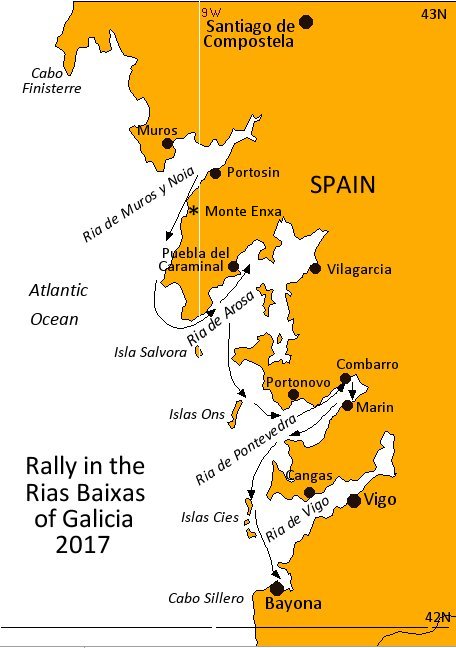 One of Europe’s most attractive cruising areas is being put to good use for the ICC’s 60-boat Galician Rally, which starts heading southward this morning on a ten day programme
One of Europe’s most attractive cruising areas is being put to good use for the ICC’s 60-boat Galician Rally, which starts heading southward this morning on a ten day programme
A successful cruise-in-company is a decidedly finely-judged affair, as you have to organize sufficient specific events to give the fleet movement a sense of coherence, yet at the same time you have to allow for the fact that genuine cruising enthusiasts will want time to themselves, while others will want to form small mini-groups having their own cruises-within-the-cruise.
With the rally making full use of one of Europe’s finest cruising areas, the experiences of the next ten days should provide a unique opportunity for those new to Galicia to get to know one of the most interesting corners of Europe. And as for the local people who live there in the many and varied coastal villages and small towns, quite what they’ll make of 60 Irish boats and their enthusiastic crews making their way along their fine coast remains to be seen. But we’ve no doubt that many new and enduring friendships will emerge.
 Far into the future, the 2017 Galician Rally flag will be a treasured souvenir
Far into the future, the 2017 Galician Rally flag will be a treasured souvenir
Cool Route: Not About Sailing from Cork to Tromso But Enjoying Cruising Grounds on its Route
The Cool Route Project, funded by the EU’s Northern Periphery and Arctic Programme and led by Cork Institute of Technology, commenced in June 2015. Since then, as Afloat.ie reported previously, project partners in Ireland Northern Ireland, Scotland, the Faroe Islands and Norway have been working hard to study and develop strategic initiatives to build the route, covering all of the cruising grounds between Cork and Tromsø, as a world recognised cruising area.
The project workpackage to develop a Route Marketing strategy was led by project partner, The Royal Cork Yacht Club, based in Crosshaven, Co. Cork. Before developing the strategy, The Royal Cork, in the almost complete absence of statistics on sailing in Northern Europe, had to undertake a number of different studies.
The first study undertaken was a Cruising Preferences Study, with over 500 highly qualitative responses received, mainly from Ireland and the UK - the study highlighted the needs preferences and priorities of cruising sailors. A key finding being that the preferred daily journey was 25 nautical miles.
Cruising folk also like very much to have a dry step ashore, be that on to a marina or a pontoon. If they have to moor offshore, they are slightly in favour of anchoring rather than using a public mooring, stating reasons of distrust.
 New pontoon facilties in Killybegs in County Donegal are important to the establishment of the Cool Route. Photo: WM Nixon
New pontoon facilties in Killybegs in County Donegal are important to the establishment of the Cool Route. Photo: WM Nixon
An interesting finding of the comprehensive study was that 65% of respondents stated that they would consider chartering as an option to explore different areas of the route.
Equipped with the preferred daily cruising distance, partner Glasgow Caledonian University, was then positioned to complete its Route Logistics Study and Gap Analysis. The logistics study clearly demonstrates that, with the exception of the west coast of Ireland, there are no distance gaps of over 25mnm, other than the sea crossings from Northern Ireland to Scotland and Scotland to the Faroe Islands and Norway. There are a number of facilities gaps in terms of showers and toilets.
Ideally the project would like all stopovers to have these facilities. Waste disposal is also an issue, and failed to find a suitable solution, as areas around local bins were consistently being used for fly-tipping. The project has also researched, and made recommendations, on a modular design for a toilet and shower block, which is manufactured from recycled shipping containers, easily transported and installed.
The next research task completed towards the finalisation of the marketing strategy was to undertake a Route Traffic Study. The study estimated the total numbers of cruising vessels located throughout the route and also calculated the numbers and locations of vessels within a two day voyage of any part of the route. In all there are in excess of 150,000 vessels capable of voyaging different parts of the route.
Gavin Deane, General Manager at The Royal Cork, stresses that: “The Cool Route is not about sailing from Cork to Norway, but enjoying all of the cruising grounds along the route. UK Boats may likely just come to the South Coast of Ireland for a week, or Northern Ireland and Scottish boats may make reciprocal trips. The project is firmly focussed on bringing new marine borne business to local enterprises and it does not make a difference if the visiting boat originated its voyage 10 miles or 100 miles from its destination. The important aspect is that a visiting craft bring business to local harbours.”
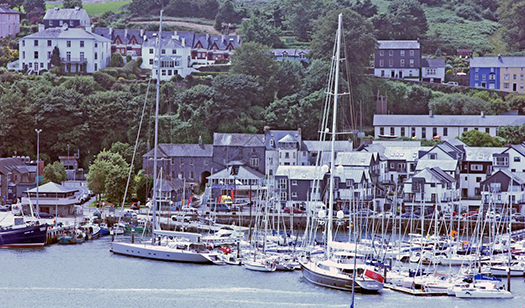 Superyachts moored at Kinsale in County Cork
Superyachts moored at Kinsale in County Cork
During the summer of 2016 partners in Ireland and Scotland witnessed a growth in the numbers of superyachts visiting. A focus group of 25 superyacht skippers was assembled and the feed-back was clearly to immediately market the route to these craft, who were actively looking for new voyages. Superyachts do not require any additional facilities than ordinary cruising craft with an emphasis on a dry step ashore and facilities to take and recycle waste.
Visits to areas of the route by small liners with 100 or so passengers was also a developing trend.
The Royal Cork Yacht Club, as part of its Cool Route marketing brief, has now produced a very high quality Superyacht Marketing Brochure, containing both generic information on the overall route, as well as a set of national inserts on reach of the participating coastal areas. The brochure is available in hard copy for circulation to superyacht and small liner operators, owners and skippers and also in an online version which can be downloaded here
In publishing the Route Marketing Strategy, which can be downloaded here, the partners are calling on higher levels of proactivity by local ports to encourage visitors.
Dr Breda Kenny, Head of the Hincks Centre for Entrepreneurship Excellence at CIT, who is leading the project said
“The strategy involves action by the main beneficiaries. This may involve organising weekend events at ports, perhaps including a barbecue or music and entrainment.Twenty visiting boats can bring between 60 to 100 visitors, the presence of boats in your harbour will bring as many day visitors and this combined effect can have significant economic benefits for local shops, cafes, restaurants, museums etc.”
One of the main strategic actions proposed is for national yachting associations and clubs in Ireland, Northern Ireland and Scotland to organise a Cool Route stand at International Boats Shows. The shared stand will have a much greater impact that any one of the individual stands – It will market all of the Cool Route as prime world cruising grounds. National interests will still compete for the business – but to a significantly larger audience.
All of the Cool Route research and studies to date can be viewed and downloaded here.
#RNLI - Lough Ree RNLI’s lifeboat crew were alerted by the Irish Coast Guard to two separate incidents on Saturday 27 May.
The first alarm was raised at 11.04am when two people on board a 32ft motor cruiser ran aground north-west of Inchbofin Island, near the eastern shore of the lake.
Lifeboat operations manager Tony McCarth, assisted by shore crew Bernard Larkin and Denis Begley, had Lough Ree lifeboat The Eric Rowse launched and underway in less than 15 minutes with crew members Stan Bradbury, Kieran Scullion and Stewart McMickan on board.
Weather conditions at the time were difficult, with heavy rain and a strong Force 4 breeze from the north-west. Visibility was poor and there was a moderate swell on the lake.
The Eric Rowse was alongside the casualty vessel at 11.31am, with the lifeboat crew checking that all on board were uninjured and wearing life jackets. Once established that the vessel was not taking on water, the lifeboat towed it off the sandy shoal to safe navigable water.
All equipment on the boat was confirmed to be in good working order, and the people on board were able to continue their journey to Lanesboro at the north end of Lough Ree.
The lifeboat crew returned to station at Coosan Point, where the shore crew prepared The Eric Rowse for service once again by 12.30pm.
Less than three hours later, 3.15pm, the volunteers were alerted again – this time to assist eight people aboard a hire cruiser aground north of the Black Islands, at the north-east shore of Lough Ree.
Launch authority Billy Henshaw and shore crew member Bernie Larkin launched the lifeboat at 3.26pm, crewed again by volunteers Bradbury, Scullion and McMickan.
The lifeboat crew reached the cruiser at 3.49pm and proceeded to conduct the usual checks before towing the cruiser to safety. The eight people on board then continued their journey south to Athlone, and the lifeboat crew returned to the station, where The Eric Rowse was reported ready for service again at 4.50pm.
Speaking later on the day, Tony McCarth said: “We were happy to be able to assist in both callouts today and to help these 10 people continue to enjoy their weekend on Lough Ree.
“Heavy rain leads to poor visibility on the lake, which can make locating navigation markers difficult, even in calm conditions. We remind all users of the lake to ensure they check the weather forecast and seek local advice on likely conditions on the lake before leaving harbour.”
The Cruising Association of Ireland is already well into a busy season in 2017, but it moves up a gear this weekend with the AGM at Howth presided over by Commodore Clifford Brown tomorrow (Saturday) at 1800hrs, and based around a rally of East Coast members and their boats followed by a dinner, with CAI folk from other parts of Ireland travelling overland to the venue writes W M Nixon.
Last year the CAI AGM & Rally in the Spring was used to mark the opening of the new Greystones Sailing Club with GSC Commodore Dave Nixon as CAI’s Guest of Honour. This year in the more mature marina at Howth, the home club are celebrating the 30th Anniversary of their clubhouse – a winner of architectural awards when it was opened in 1987 – while the marina itself has been in action for nearly 35 years.
The CAI programme in 2017 is impressive, as they started with the Kish Muster in Dublin Bay on 8th April with the overnight at the hospitable National YC. This weekend of May 13th-14th, the focus swings to Howth, then on June 3rd to 5th a significant contingent will be at the Dublin Port festival, while they’re back to meet their old friends in Greystones on 10th to 11th June.
This year’s Cruise-in-Company is focused on Belfast Lough from July 3rd to 10th, then after a mid-season hiatus when many members expect to be doing individual cruises, they gather again on 12th August for an East Coast Rally at either Arklow or Carlingford, depending on the weather. Their East Coast season is rounded out by the traditional and popular Liffey 3 Bridges Cruise on 16th/17th September, when the opening bridges in the heart of Dublin are co-ordinated to allow the CAI fleet through for an convivial assembly which culminates in feasting aboard the Dublin Restaurant Ship Cill Airne.
 The popular Cruising Association of Ireland 3 Bridges Cruise in September sees the Liffey bridges co-ordinated for a shared opening time to allow the fleet through. Photo : W M Nixon
The popular Cruising Association of Ireland 3 Bridges Cruise in September sees the Liffey bridges co-ordinated for a shared opening time to allow the fleet through. Photo : W M Nixon
While Saturday night’s AGM and dinner at Howth has a certain business-to-be-done emphasis to it, around a dozen boat think it’s only right and proper to sail there, none more so than the renowned Charlie Kavanagh of Wicklow. His Sadler 34 Stravaiger was wintered in a berth in Kilmore Quay, and he was keen to sail to the Howth AGM. But with a period of cold nor’easters threatening, he grabbed a brief weather window on Sunday night by press-ganging shipmate and Wicklow SC Hon. Sec. Peter Shearer into an overnight passage, and they were rewarded with fair easterly winds for a dream sail to Wicklow, admittedly in decidedly crisp temperatures.
So now Stravaiger is conveniently poised to sail north to Howth either this evening or tomorrow morning, and with his new season properly under way, Charlie Kavanagh’s plans for Stravaiger in 2017 include a leisurely Round Ireland cruise.
Sailing Circuit of Ireland for Cystic Fibrosis Fund-Raiser
After a winter which included training with Irish National Sailing School in Dun Laoghaire, Galway’s Mossie O’Reilly and Paddy Shryane are well into a clockwise Easter circumnavigation of Ireland to raise funds for Cystic Fibrosis writes W M Nixon.
Spurred on by the death from CF last summer of their friend Eva Davin aged just 32, the Galway duo are sailing fully-crewed on the INSS’s J/109 Jedi. They aren’t trying to break any sailing records, but instead are doing the classic Round Ireland circuit in a way with which most sailors will identify. This in turn will, they hope, draw attention to the remarkable work being done in Galway University Hospital, where 85 children and adults are receiving treatment for CF.
Even before their venture got under way from Dun Laoghaire in the first minute of Holy Saturday, April 15th, they and their team had already raised €2,545 towards a modest target of €3,000 which we hope will be significantly exceeded by the time fund-raising ends of August 15th 2017. Because the voyage target is simply to get round Ireland, when total calm descended off Kinsale they dropped into port for a few hours until the wind returned.
Portrush Lifeboat Assists Cruiser In Difficulty
#RNLI - Portrush RNLI’s volunteer lifeboat crew got an early callout yesterday morning (Sunday 5 March) on reports of a cruiser with three on board that had got into difficulties 33 miles offshore just south-east of the island of Islay in Scotland’s Inner Hebrides.
Weather conditions were described as ‘perfect’ with a bright morning pagers went off at 10.10am, and the crew were quickly underway at full speed due the favourable sea conditions.
When the lifeboat crew reached the vessel, a towline was quickly attached to the cruiser and it was taken under tow to Portrush at a slow and steady rate of six knots. The lifeboat crew returned to base by 4.30pm, six hours after launch.
Portrush RNLI lifeboat operations manager Robin Cardwell said: “This was a textbook exercise for the crew, and something they train for all year round. The good weather conditions assisted the recovery and good progress was made for home.”
Daragh Nagle, an ex-Pat Dub who live and sails from Victoria on the west coast of Canada, is the Afloat.ie “Sailor of the Month” for February in honour of his award of the Irish Cruising Club’s premier trophy, the Faulkner Cup, for a notably varied voyage in the Pacific from Mexico to Hawaii and then eastward back to Canada.
Although this was island-hopping in what was only a part of the Pacific, for anyone accustomed to the smaller scale of the Atlantic, the distances seem enormous. By the time Daragh’s 29-year-old Moody 346 Chantey V returned to her home port, she’d logged a total of 7,858 miles during 2016 as part of a three year venture which has seen a total of more than 25,000 miles sailed.
It was a challenging programme. But with his skillfully-updated veteran 37-footer, and well-thought-through crew changes which saw his wife Cathy sailing many of the stages involved, Daragh made a real dream cruise which has been deservedly rewarded by his home club, more recently by the Irish Cruising Club, and now by the “Sailor of the Month” award for February 2017.
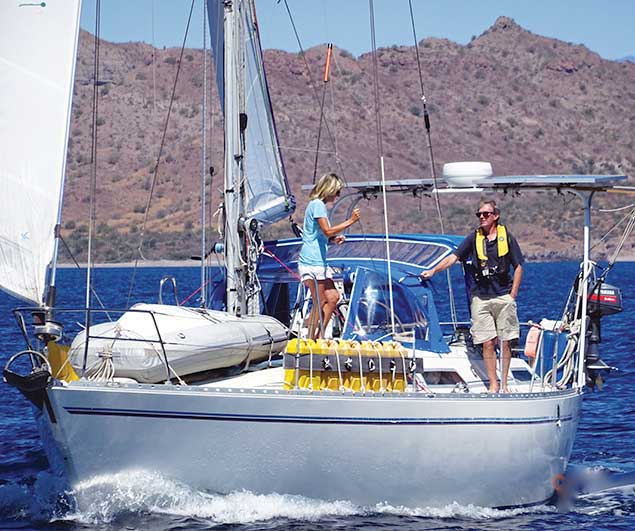 The 29-year-old Moody 376 Chantey V in the Sea of Cortez in Mexico shortly before departing for the long haul direct to Hawaii
The 29-year-old Moody 376 Chantey V in the Sea of Cortez in Mexico shortly before departing for the long haul direct to Hawaii
Midlands Waterways To Get ‘Slow Tourism’ Push In 2017
#Tourism - Boating in the Midlands’ waterways will be the focus of a major tourism push this year, as The Irish Times reports.
Fáilte Ireland’s new ‘slow tourism’ initiative will concentrate on promoting existing walking and cycling greenways and ‘blueway’ cruising routes in Midlands counties south from Lough Allen on the upper Shannon.
Minister of State for Tourism Patrick O’Donovan announced the new marketing plans in his address to the Irish Hotels Federation conference in Kilkenny yesterday (Tuesday 28 February).
“We have had the Wild Atlantic Way, Ireland’s Ancient East, and now we are working on a development plan for the Lakelands,” he said.
The Irish Times has more on the story HERE.






























